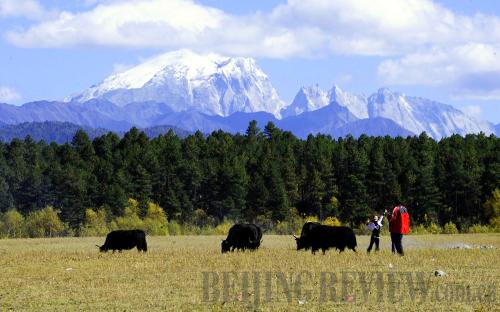|
 |
|
SACRED LAND: Tourists enjoy the peace and beauty of Shangri-La (REN YONG) |
As the Beijing autumn faded and winter began settling in, I headed off to Kunming, otherwise known as Spring City in southwest China's Yunnan Province. I landed in the impressively structured new airport just opened a couple of months ago, and welcomed the sunshine and spring breeze as I peeled off my layers of clothing.
I had always wanted to go to Yunnan because of my great affinity for Pu'er tea, but was blown away by the creative energy in Kunming. Vendors sold snacks on the street while brass bands and bongo drums filled the air with their sounds. Calligraphers practiced on the sidewalks while tourists and locals fed the Siberian seagulls on the Green Lake. As the cherry on top of this delightful street scene, I wasn't breathing smog.
I've never been one to sugarcoat the levels of pollution in Beijing, but in Kunming, it was as if a veil of gray had been lifted. Colors were brighter everywhere. Our guide told me that because the city was blessed with such temperate weather, most people had no need for the likes of air conditioning and heaters—only places like hotels installed air conditioners to cater to tourists.
After walking through the Stone Forest's towering natural cliffs and of course, purchasing some aged Pu'er tea from a hundred-year-old tree (that's right, tree, not bush), and experiencing other mandatory Kunming sights and sounds, my travel companions and I headed north to Dali, another city in Yunnan.
As we walked along the old walled city in Dali, I couldn't help but feel slightly remorseful for the state of the old town. It was clean, sure, but it was also heavily commercialized. Lijiang, our next destination, also had an old town and while beautiful, especially at night, was catered very specifically to tourists. Lijiang had the same eclectic feel of Kunming, with the celebration of diversity and creativity, but it was also a town heavily dependent on tourism alone. So we moved on.
Every city we moved to was higher and higher in altitude and colder and colder in temperature. In Dali, we began to feel the crisp, winter air and in Lijiang, the hats and gloves made their appearances. We found ourselves next in Zhongdian, which is more famously known as Shangri-La. The prefecture was renamed in 2002 to boost tourism and was the coldest and highest point of our journey. At this stage, some of the older members in the group had begun to feel tinges of altitude sickness—feeling tired but not being able to sleep at night in addition to nausea.
If only yak meat was a cure for altitude sickness, since we ate much of it in Shangri-La. A staple in the highland diet, it was the kind of dish one would want in their bellies on a cold winter's night. I ate heartily whenever the yak meat came out but when the yak butter tea was served, it was hard to even take a second sip.
To anyone curious about how it tastes, it is just as it sounds—something like a milk tea mixture with a stick of butter thrown in. It helps keep people warm, our Shangri-La guide said. But within our group which included chefs and food connoisseurs, we were hard-pressed to find any fans of the local tea. The members of our group settled instead for cans of oxygen, specifically bottled for those afflicted with altitude sickness.
The winding road between Lijiang and Shangri-La didn't help the feelings of nausea either. The dirt and concrete road that connects the two cities together winds up and around mountains, railway construction sites and across one of the world's deepest gorges: the Tiger Leaping Gorge. It is a four- to five-hour bus journey that until recently only a few, adventurous travelers would take.
A railway is in the midst of construction to connect Dali, Lijiang and Shangri-La, but with completion still scheduled for 2015, travelers wanting to see the fabled Shangri-La will have to take a bus.
The bus ride, no matter how bumpy the road was on the way, was well worth it. With the greens turning into browns from the cold weather, it wasn't the flora or fauna that was the most impressive sight in Shangri-La. It was the night sky.
When the sun goes down and people start retiring to their homes, it isn't the city lights that impress. So high up and so close to the roof of the world, all one has to do is look up and see entire nebulas with the naked eye. Hundreds, maybe even thousands of stars dot the sky and it wasn't uncommon to see the orange twinkle of Mars or distant blue of Neptune hovering over grazing yaks. With nothing but the stars and yaks to keep you company, it is no wonder people settle to find inner peace in Shangri-La.
Today, with tourists pouring in expecting to have their picture taken over a "Welcome to Shangri-La" sign, it is hard but more important than ever to remember that while the fictional haven from Lost Horizon has come to life, its meaning can only be realized in person.
The author is a Canadian living in Beijing
Email us at: zanjifang@bjreview.com | 